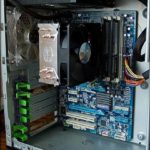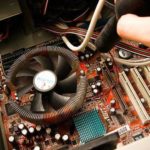Most people cringe at the thought of having to open up their desktop computer’s cabinet, and removing and replacing items. And so installing a motherboard, understandably, would conjure up images of smoking computer components and unequaled human error.
But the truth is that anyone can install a new motherboard and CPU if they are prepared. The key is to overcome a common fear of many, which is opening the computer case. Once that’s been accomplished, the feeling of accomplishment, what you’ll learn and the money you save will be big bonuses to add onto the increased speed and performance your new motherboard will give you.
Having Help When You Need It
There are a number of quality online communities which will help you through your first motherboard installation. Looking for those communities devoted to the choosing, buying and installation of motherboards will offer specialized knowledge. But of course, since the computer you’ll be working on will be offline, it will certainly help to have access to the internet via another computer, your smart phone or a tablet if you get stuck and need some expert advice.
Knowing the Technical Terms

Image by Flickr user : The Hidaway (Simon)
There are a few parts that you will be involved with as you are installing your new motherboard. And it’s good to know the language, especially if you need some online advice.
The I/O shield – located at the back of your computer, this thin piece of metal allows you to connect things like your keyboard and mouse to your PC. I/O simply stands for ‘input/output’.
CPU – the central processing unit, which represents the brains of your computer. This is where all of your computer’s processes happen when you turn your machine on or click a program with your mouse.
Heat sink – this is usually considered to be one unit with your computer’s fan. But the actual heat sink is a silver-colored ‘block’ of metal that sits underneath your computer’s fan. The heat sink helps distribute the heat generated by computer components more evenly, preventing the overheating of those components.
Motherboard – last but not least, the motherboard is the main circuit board of your computer. It is what all of your computer components, such as your hard drives and PCI cards plug into.
Before You Install
If you haven’t yet done so, you may want to consider whether your CPU is compatible with your motherboard, and whether your computer’s case can handle the size of the motherboard you purchased. The answer to this can be found at many online resources, or at the store where you purchased your motherboard and CPU if you didn’t purchase it online. If the sizes aren’t correct, you will need to return your components to where you purchased them and get the correct size.
It’s also important to be aware that any static charges can permanently damage any circuit boards that you touch during installation. And so ensuring that you ground yourself often by touching a metal object will help to dissipate any static buildup as you’re working inside your computer. Your computer should be unplugged during the entire motherboard installation process.
The I/O Shield
Your new motherboard will have probably come with its own I/O shield, so that the ports on the back are compatible with their corresponding locations on the motherboard. Removing the I/O shield is simply a matter of either unscrewing it or gently pulling it away from the rest of the case. Replacing the shield should be done as gently as possible to avoid bending the shield out of shape.
The CPU
Installing the central processing unit is a simple task. But the CPU itself is very delicate. It is installed in the area of the motherboard that has a small plastic ‘arm’. Simply move the arm to open the grip for the socket. Then, look at the bottom of the CPU, and ensure that it’s turned the right way to go into the socket. Once you’ve set it in, move the arm back into its original position to lock it.
The Motherboard

Learning how to install a motherboard is your first stop in learning how to install computer components (Image by Flickr user : coldpants)
The motherboard will then need to be fitted into your cabinet. Most cabinets will match the positions of the screw holes on the motherboard. You will need to ensure that the motherboard is aligned properly with the I/O shield. If the alignment is correct, you can then begin screwing the motherboard into the I/O shield. You may have to consult the manual that came with your motherboard to ensure that it’s been connected properly to ensure optimal power.
The power supply switch will then need to be connected. Usually labeled PW-SW, it is where the P-ON or PW connector on your motherboard will connect. Once all connections are secure, screw in all the adapters at once.
[Read also: Maintaining Your Computer Saves You Money on Repairs and New Purchases]

I got detailed help from your tutorial. Recently bought one Motherboard for my old desktop. This tutorial came in handy.. Thanks Peter.
You’re welcome, Avi. I’m glad you stopped by. Thanks! 🙂
Motherboard is one of the most important parts of the computer, extra careful should be taken to keep this motherboard last long .Not only the motherboard but all the parts of the computer. The computer must have a computer cabinet to protect it from any damages and risks aside from that having this cabinet will keep your computer and its stuff organized.
A motherboard is the main board of the computer. It contains all necessary parts such as CPU , your drives such as your HDD or CD/DVD burners etc. The motherboard is the biggest necessary part required for the computers.
Your article is very help to mother board installation and protect it from the damages and risks.
Thanks for sharing this.
Very informative article.
I like reading these practical experience that gives learning readers like me.
Thanks a lot.
hi Peter!
your information to installing the motherboard in your computer is good.so i will use your tips when i install the motherboard in my system.i like your blog and thanks for sharing this information.
Another job well done Peter! The motherboard is very confusing and setting it up much more complicated. Thank you for sharing with us some few key terms we need to remember in setting up our motherboard. Keep blogging Peter, your articles are interesting! 🙂
Hi Elizabeth,
Installing such a motherboard is something that I may not get to do. I admit that I am not a techie and tinkering and fiddling with computer insides is not exactly my cup of tea. Fortunately, I have a trusty brother whom I can rely on such things. Anyways, you have a pretty good explanation here though and I actually have learned something new.